Homemade Rye Bread
Homemade Rye Bread has great flavor thanks to honey, caraway seeds and a long slow rise. Start this rye bread recipe night before to have fresh bread for lunch.

I’m a huge fan of rye bread in just about any form. If you’ve got a bread starter I highly recommend my Sourdough Rye Bread, Sourdough Rye Crisp Bread or Sourdough Pumpernickel Bread. I also recommend this recipe for Marble Rye Bread.
I’m kind of picky about Rye Bread, so it’s always homemade in our house.
But this rye bread recipe is so easy there’s no reason not to bake it yourself.
If you want fresh bread for lunchtime, start the night before and your bread is half way done when you get out of bed.
And that overnight rest is not only good for you, it’s also really good for the taste and texture of your Rye Bread.
Ingredients
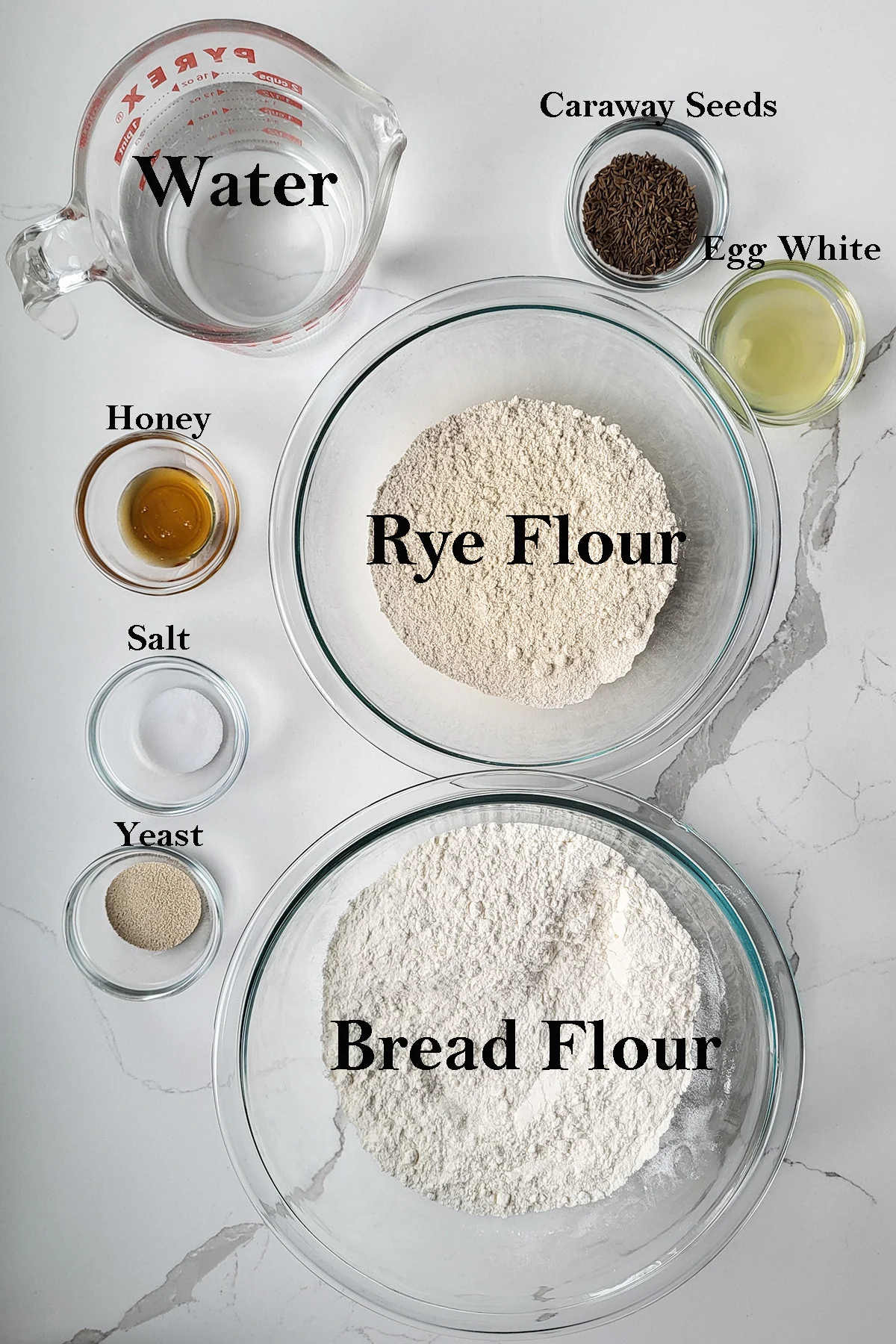
Ingredient Notes
- Rye Flour does not have the gluten forming properties of wheat flour. Use any type of rye flour in this recipe, light, medium or whole grain. Stone ground rye flour has an especially nice flavor and texture.
- Bread Flour is a wheat flour with a high protein content. Higher protein means better gluten development.
- Instant Yeast I prefer instant yeast to rapid rise yeast for a slightly slower rise.
- Honey adds the slightest sweet note which works very well with the flavor of rye flour.
- Caraway Seeds add the characteristic “rye bread” flavor, but they are optional.
How to make Rye Bread:

- Combine the water, yeast, rye flour and 1 cup of the bread flour in a mixer bowl. Set aside for 30-60 minutes.
- During the resting time the sponge will activate the yeast, the flour will absorb water, and the gluten will start to form.
- Add the salt and honey to the sponge. Add the rest of the bread flour.
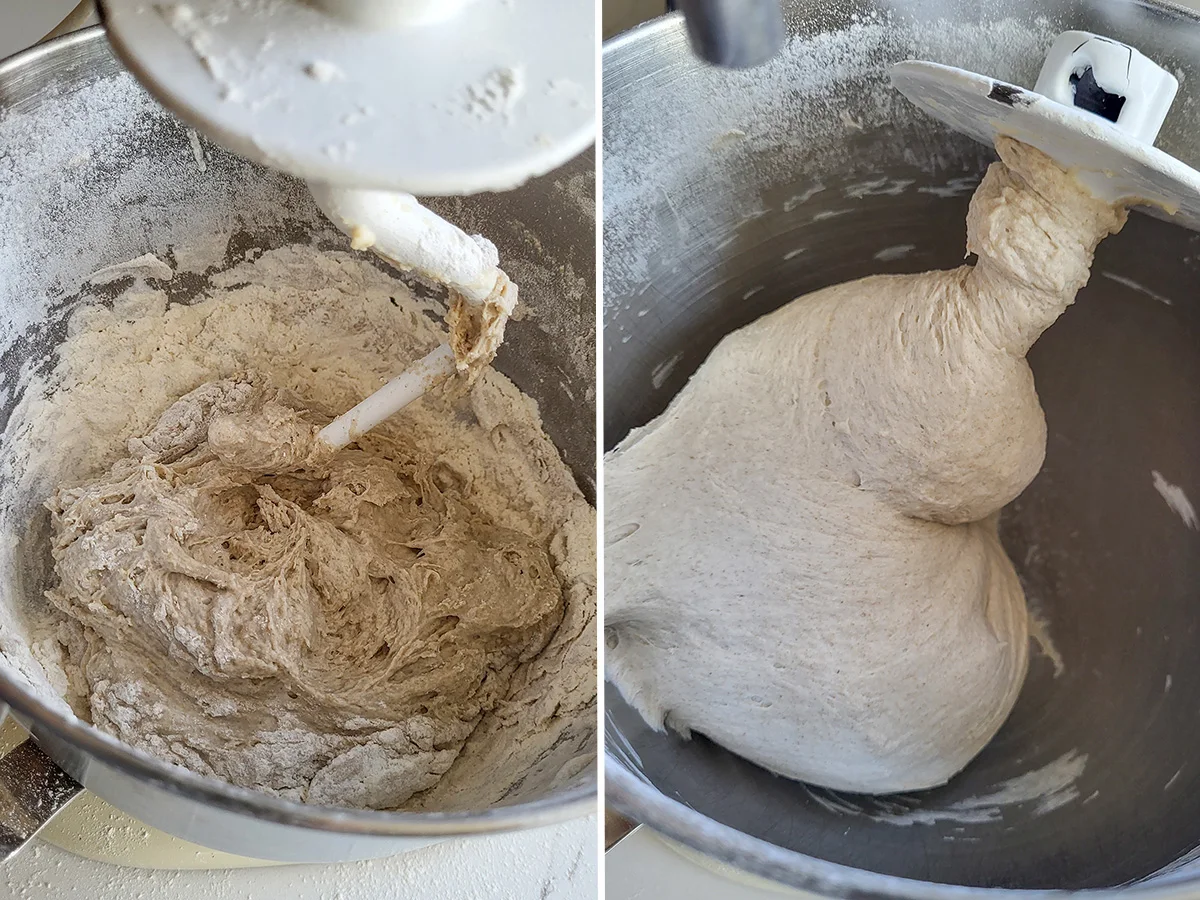
- After adding the rest of the bread flour the dough will be quite sticky and shaggy.
- After 5 minutes of kneading the dough should gather on the hook and clear the sides of the bowl.
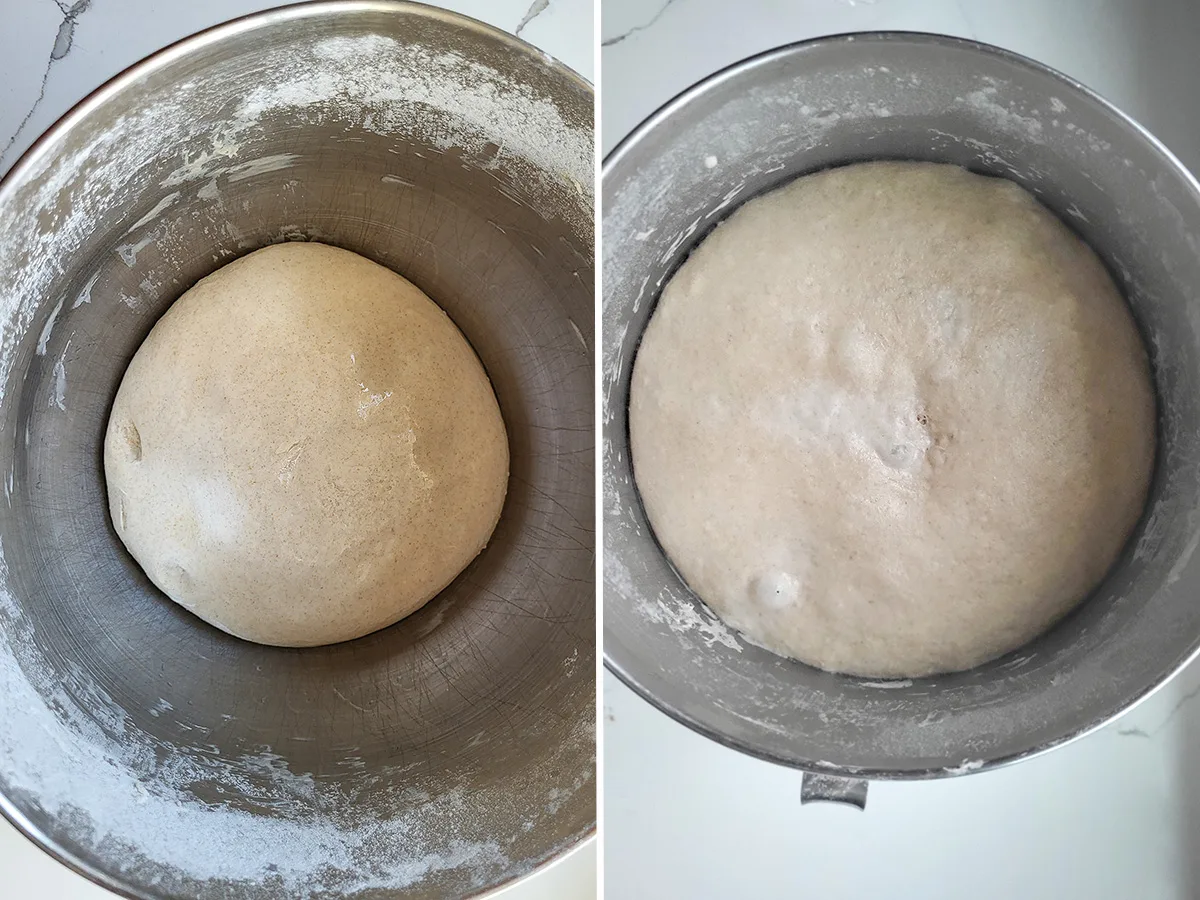
- Let the dough rise 1x, then punch it down. Put the dough back into the bowl. Cover the bowl and refrigerate overnight.
- By the morning the dough should have risen again.
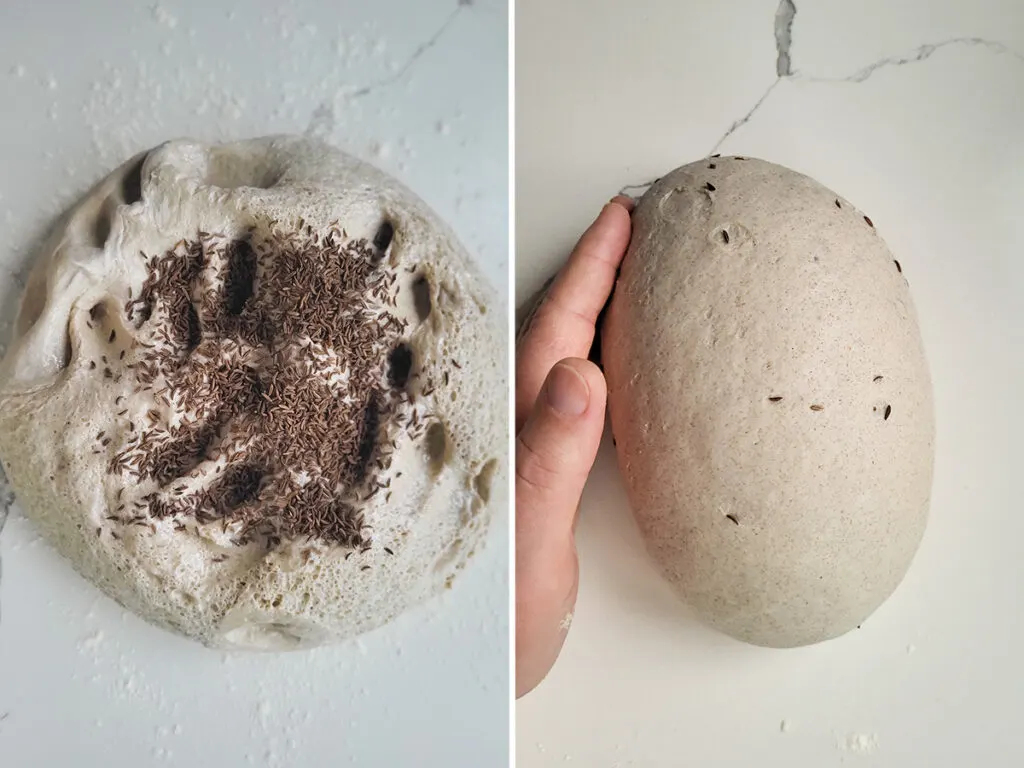
- Sprinkle caraway seeds on top of the dough. Knead the seeds into the dough and shape the loaf.
- Cover the loaf and set aside to rise until doubled in volume.
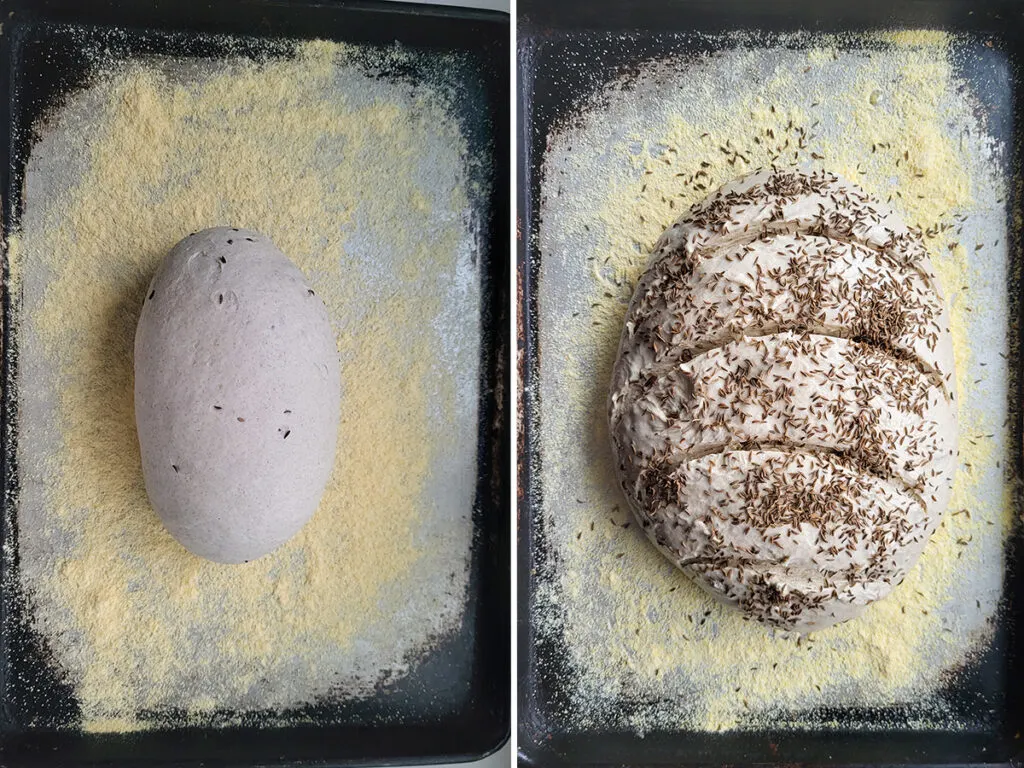
- Once the loaf has doubled in size, make 5 slashes across the top of the loaf, brush it with egg white, and sprinkle with the rest of the caraway seeds.
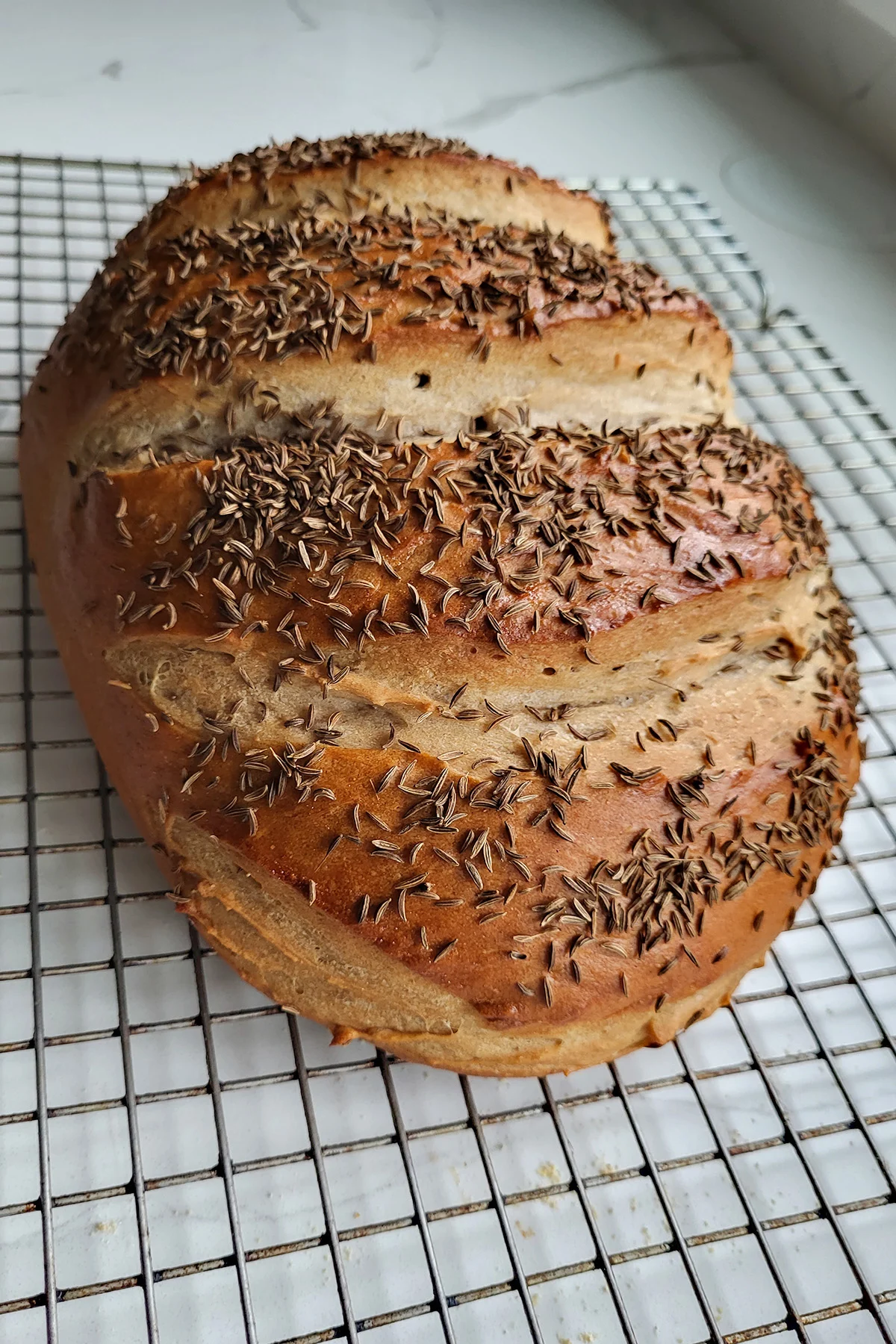
- Bake until the loaf is golden brown and the internal temperature of the loaf is 200F.
A timeline for making Overnight Rye Bread:
- Mix the dough the evening before baking day. Refrigerate the dough before going to bed.
- Take the dough out first thing in the morning and shape the loaf.
- Leave the loaf at room temperature to rise for 1 – 1 1/2 hours.
- The dough can be baked the same day it is made. The entire process, including cooling time, takes about 5-6 hours. To have bread ready for lunch, start before 7am.
- If you use rapid rise yeast your rising times will be quite a bit faster, possibly half the time. But remember, the longer rise creates a better tasting loaf.
How to Enjoy Rye Bread
A slice of fresh rye bread slathered with good butter is a simple and perfect treat. But there are many ways to enjoy this bread.
Rye Bread is essential for the classic Reuben Sandwich. Take two slices of rye bread and layer them with corned beef, Swiss cheese, sauerkraut, and Thousand Island or Russian dressing. Grill the sandwich and enjoy.
Rye bread is also traditional in a tuna melt. Stuff two slices of rye bread with tuna salad and swiss cheese. Grill until the cheese is melty. Yum.
How to Know when the Rye Bread is Done
The best way to know if your rye bread is done it to use a probe thermometer to check the internal temp. When the center of the bread registers 200F the bread is ready.
If you don’t have a probe thermometer you can try and judge if the bread is done by the color and weight of the loaf. A perfectly baked loaf of rye bread should be golden brown and will sound hollow if you tap the bottom of the loaf.
How to Store Rye Bread
Rye bread keeps extremely well at room temperature for 2-3 days. For longer storage slice the loaf, store the slices in a freezer bag and freeze for up to a month. Defrost or toast the bread as needed.
Pro Tips for making Rye Bread in a Dutch Oven
- Instead of forming the loaf into a football shape, form the dough into a round and place it on a sheet of parchment paper. Preheat a Dutch oven in oven while the bread rises.
- Remove the preheated pan from the oven and remove the lid. Use the parchment paper to lift the loaf into the Dutch oven. Replace the lid on the pot and slide it into the oven.
- Bake for 20 minutes. Remove the lid from the Dutch oven. The loaf should be well risen and pale in color. Continue baking another 20 minutes until the loaf is nicely browned and beginning to crisp.
- Remove the pan from the oven. Use the parchment to lift the loaf out of the pan. Use the parchment to place the loaf directly onto the rack in the oven. Bake another 5-10 minutes until the loaf is deeply browned and very crisp. Total baking time is about 40-50 minutes.
More Artisan Bread Recipes
- Marble Rye Bread
- Homemade Bagels
- Multi Grain Bread
- Milk & Honey Whole Wheat Bread
- Honey Oatmeal Bread
- White Sandwich Bread
- Hoagie Rolls
- Crusty Semolina Bread
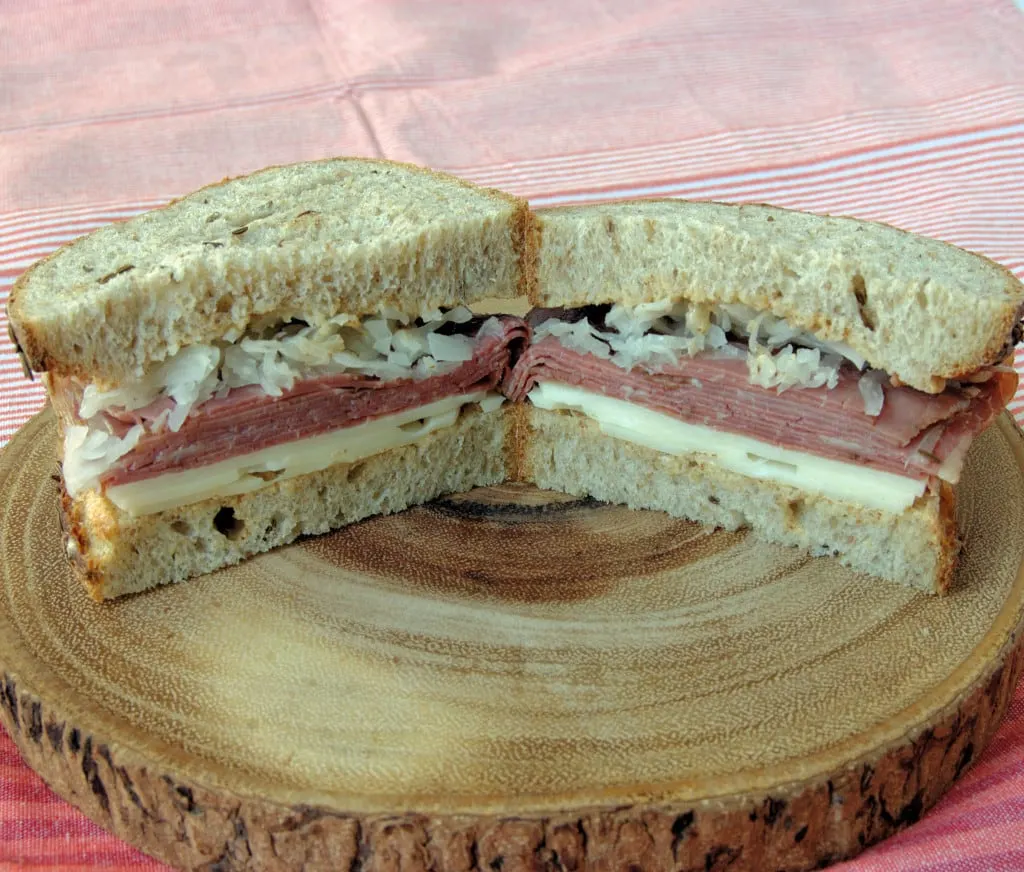
If you love this rye bread recipe as much as I do, I’d really appreciate a 5-star review.
Homemade Rye Bread Recipe
Ingredients
- 16 ounces warm water (2 cups)
- 2 ¼ teaspoons instant yeast
- 5 ounces rye flour (1 cup, see note)
- 16 ¼ ounces bread flour (3 ¼ cups)
- 1 tablespoon honey
- 2 teaspoons table salt
- 2 tablespoons caraway seeds
- 1 egg white
Instructions
- Combine 16 ounces warm water, 2 ¼ teaspoons instant yeast, 5 ounces rye flour and 1cup (5 oz) of the bread flour in a mixer bowl. Mix until a thick batter is formed. Cover the bowl and set aside for 30-60 minutes.
- If you're using a stand mixer, switch to the dough hook. Add 1 tablespoon honey, 2 teaspoons table salt and and remaining bread flour. If the dough is extremely sticky sprinkle in a few more tablespoons of bread flour.
- Knead the dough on medium speed for 5 minutes or until the bread clears the sides of the bowl and clings to the hook. Turn it out onto a lightly floured surface. If working by hand, stir in as much of the flour as you can then turn the dough out onto a floured surface and knead for 4-5 minutes.
- The dough may be a little sticky so keep your hands well floured. Place the dough into a lightly oiled bowl, turning once to coat the dough. Cover the bowl.
- Rise for 1 to 1 ½ hours or until doubled in size. Turn the dough out onto a lightly floured surface. Knead the dough, cover tightly and refrigerate over night or up to 24 hours. To bake the same day you can skip the refrigeration step and go straight to shaping the loaf.
- Remove the bowl from refrigerator and dump the cold dough onto floured surface. Sprinkle the dough with 1 tablespoon caraway seeds and and knead to distribute the seeds.
- Knead the dough into a smooth ball then taper the two ends for form a football shape. Place the loaf on a wooden peel or sheet pan sprinkled liberally with corn meal. (It you plan to bake in a Dutch oven see notes below)
- Cover and leave in a warm place until doubled in size and the dough springs back slowly when poked, about 1 hour. Meanwhile, preheat the oven to 400 °F. If you have a baking stone place it in the oven to preheat.
- Make 5 diagonal slashes in the dough with a single edge razor or very sharp knife. Brush the dough with egg white and sprinkle with another tablespoon of caraway seeds. Slide the dough onto the preheated stone or slide the sheet pan into the oven.
- The bread is ready when the internal temperature of the loaf is 200 °F. Baking time is approximately 35 minutes.
- Cool completely on a wire rack before slicing.
Would you like to save this recipe?
As an Amazon Associate and member of other affiliate programs, I earn from qualifying purchases.

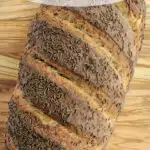
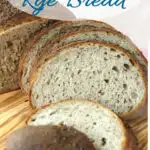
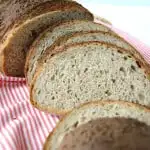




Hi Eileen,
Thanks for posting my pic on your Facebook page – I’m flattered!
I had a look at your Cracked Wheat Bread. It does look very tempting. I will have to scout around to see if I can lay my hands on the right ingredients. Maybe it is what is known as ‘crushed wheat’ or possibly whole wheat flour in our local stores.
On our supermarket shelves we typically seem to have: white bread flour, brown bread flour, nutty wheat and whole wheat flour. Then, of course Rye flour in some stores.
Off the bread scene, I have been baking plum turnovers with much admiration from family and friends. During late Summer we get these lovely large black plums with small stones. Their taste is nice and tangy – a bit of sugar is added however. The pastry is based on white bread flour, milk, butter, egg and dry yeast.
As it is fall now the plums won’t be available anymore and I’ll have to switch to Apple turnovers!
With kind regards.
The bread was a hit on my Facebook page, as I’m sure it was at home. “Crushed Wheat” sounds like it might be similar to cracked wheat. I have photos of the cracked wheat in the post you can look and see if they’re the same.
The plum turnovers sound wonderful.
Thanks for the photo. It looks great. Nice crumb and crust on the bread. If you like this recipe you might want to try my “Cracked What Bread” next.
I posted the photo of your loaf on the Baking Sense Facebook page.
Hi Eileen,
Success!!
The bread is the best rye bread that I have ever baked. Texture great and tastes soo good.
Thanks for your great help.
Yes, you are right. I am contacting you from South Africa. We spent 7 weeks in Texas from Thanksgiving and into January this year, visiting our daughter and family of 5 grandchildren. It was great fun baking all sorts of breads for them and yes, a loaf was flattened in a day. That way I could keep going whilst here with just the two of us, it takes a while before our frozen bread is used up, justifying baking a new loaf.
I’ve taken pics but just don’t know how to attach them.
I’m so glad you had success. My husband and I are empty-nesters so we usually have to freeze left over bread when I bake. If you are on any social media such as Facebook, Twitter or Instagram you can post a photo and tag me.
Thanks for your quick response, Eileen!
I’ve got one on the go right now. Followed your recipe and method. Just waiting for it to prove first time and then I’ll knead it down and place it in the refrigerator over night. Let’s see what happens tomorrow! – I’ll let you know.
Just one observation: I’ve used up all the bread flour portion but the dough is still rather soft and sticky. (much softer than what I have made before). I needed to use a little flour to get it from the mixing bowl and to be able to handle it and place it into the oiled second bowl. Does that sound about right?
Hi Paul,
It is a fairly sticky dough. But as it proofs it should get easier to handle. Flours can vary by country (it looks like you’re not in the US?). So if it’s still too sticky to handle in the morning knead in a little more white flour.
Your bread looks just like what I would like to produce!
Admittedly, I have not given it the overnight slow rise treatment but rather used warm ingredients and let it prove in a slightly pre-warmed top oven (just slightly warm to the touch). First rise for about 1.5 hours then knead down and form into a loaf. Second rising about 1 hour. Sour dough starter and additional dry yeast.
Equal parts Rye and white bread wheat flour (300gm each). I add about 30 gm sunflower seed oil to 1kg dough.
The consistency of the dough is firm enough to knead and requires a sprinkling of flour to prevent sticking to the board surface.
Here comes my question:
How do I prevent the loaf spreading sideways? My loaves always turn out fairly flat and the texture is not springy. Am I allowing it to over-prove?
Hi Paul, It’s hard to say what the problem is without seeing the entire recipe and process. So much about bread making is dependent on time and temperature. My first thought is that putting oil in the dough could weaken the gluten. It doesn’t look like a lot of oil, but that might be part of the problem. You could also try using slightly more bread flour than rye flour.
Try less water, too much and it wont hold its shape.
I make this bread all the time and don’t have a problem shaping the loaf. Make sure to allow the sponge to work before mixing the dough, this will help the water absorb into the flour and start the gluten development. Be sure to use bread flour, not all purpose flour. Bread flour will absorb more water than ap flour. Also knead the dough for a good 3-5 minutes to develop the gluten. A strong, moist dough will produce a bread that is moist and light. This is a stickier dough and, as noted in the recipe, you can sprinkle in a little more flour as you knead to make it easier to handle.